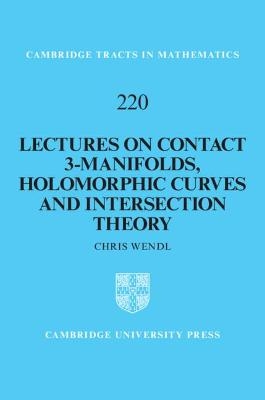
Lectures on Contact 3-Manifolds, Holomorphic Curves and Intersection Theory
Seiten
2020
Cambridge University Press (Verlag)
978-1-108-49740-4 (ISBN)
Cambridge University Press (Verlag)
978-1-108-49740-4 (ISBN)
Based on a series of lectures for students in topology, this book provides an entry point into the intersection theory of punctured holomorphic curves. Appendices featuring quick reference guides for applying the theory and self-contained proofs of key technical results also make it a valuable resource for researchers.
Intersection theory has played a prominent role in the study of closed symplectic 4-manifolds since Gromov's famous 1985 paper on pseudoholomorphic curves, leading to myriad beautiful rigidity results that are either inaccessible or not true in higher dimensions. Siefring's recent extension of the theory to punctured holomorphic curves allowed similarly important results for contact 3-manifolds and their symplectic fillings. Based on a series of lectures for graduate students in topology, this book begins with an overview of the closed case, and then proceeds to explain the essentials of Siefring's intersection theory and how to use it, and gives some sample applications in low-dimensional symplectic and contact topology. The appendices provide valuable information for researchers, including a concise reference guide on Siefring's theory and a self-contained proof of a weak version of the Micallef–White theorem.
Intersection theory has played a prominent role in the study of closed symplectic 4-manifolds since Gromov's famous 1985 paper on pseudoholomorphic curves, leading to myriad beautiful rigidity results that are either inaccessible or not true in higher dimensions. Siefring's recent extension of the theory to punctured holomorphic curves allowed similarly important results for contact 3-manifolds and their symplectic fillings. Based on a series of lectures for graduate students in topology, this book begins with an overview of the closed case, and then proceeds to explain the essentials of Siefring's intersection theory and how to use it, and gives some sample applications in low-dimensional symplectic and contact topology. The appendices provide valuable information for researchers, including a concise reference guide on Siefring's theory and a self-contained proof of a weak version of the Micallef–White theorem.
Chris Wendl is Professor of Differential Geometry and Global Analysis at Humboldt University of Berlin. He is the author of Holomorphic Curves in Low Dimensions: From Symplectic Ruled Surfaces to Planar Contact Manifolds (2018), and a recent recipient of an ERC Consolidator Grant.
Introduction; 1. Closed holomorphic curves in symplectic 4-manifolds; 2. Intersections, ruled surfaces and contact boundaries; 3. Asymptotics of punctured holomorphic curves; 4. Intersection theory for punctured holomorphic curves; 5. Symplectic fillings of planar contact 3-manifolds; Appendix A. Properties of pseudoholomorphic curves; Appendix B. Local positivity of intersections; Appendix C. A quick survey of Siefring's intersection theory; References; Index.
| Erscheinungsdatum | 26.03.2020 |
|---|---|
| Reihe/Serie | Cambridge Tracts in Mathematics |
| Zusatzinfo | Worked examples or Exercises; 2 Halftones, black and white; 18 Line drawings, black and white |
| Verlagsort | Cambridge |
| Sprache | englisch |
| Maße | 156 x 235 mm |
| Gewicht | 390 g |
| Themenwelt | Mathematik / Informatik ► Mathematik ► Analysis |
| Mathematik / Informatik ► Mathematik ► Geometrie / Topologie | |
| ISBN-10 | 1-108-49740-3 / 1108497403 |
| ISBN-13 | 978-1-108-49740-4 / 9781108497404 |
| Zustand | Neuware |
| Haben Sie eine Frage zum Produkt? |
Mehr entdecken
aus dem Bereich
aus dem Bereich
Band 5: Hydraulik, Stromfadentheorie, Wellentheorie, Gasdynamik
Buch | Softcover (2024)
De Gruyter Oldenbourg (Verlag)
59,95 €


